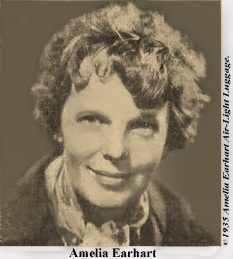|
|||||||||||||||||||
After returning from a fruitless morning flight, the three catapulted aircraft made an equally
discouraging exploration of Canton island, largest of the group.
And in San Francisco George Palmer Putnam, husband of the aviatrix, abandoned the
sleepless vigil he has maintained since the last message came from the plane a week ago
Friday and departed for his home in North Hollywood.
“There is nothing further I can do here,” he said before his departure. “It is not that I have given up hope. I am sure they will be found when the Lexington reaches the scene, but I can get the news just as quickly in Hollywood as I can here.” He was accompanied on the United Air Line airplane to Los Angeles by his son from a former marriage, David Binney Putnam, 24. Chief hopes of those who believe Miss Earhart and her navigator are still alive rest with the aircraft carrier Lexington, approaching the scene of the search from Hawaii. Officers aboard the giant carrier radioed the 62 planes aboard are being brought on deck and fueled, and may take off today. The Lexington is expected to arrive south of Howland Tuesday, but it is believed some of her long range planes will take to the air before she actually reaches the scene. Although navy officials did not disclose the exact part the carrier will play in the hunt, it was believed the Lexington’s flyers may first explore the Gilbert islands, about 400 miles west of Howland island. As an example of the difficulties confronting the three aviators attached to the U.S.S. Colorado, who have been flying over the South seas for several days, Lieutenant John O. Lambrecht, one of the pilots, related the details of a landing he made at Hull island, one of the few inhabited islands in the area. He brought his seaplane down to the waters of a lagoon inside the island. Great clouds of frightened birds blackened the sky as he flew to a landing and a throng of awe-stricken natives rushed from their huts. It was the first airplane any of them had ever seen. His motor idling, Lieutenant Lambrecht waited in the lagoon until a canoe manned by the entire population of 30 Polynesians and one white man was paddled alongside. The sole white man, an Englishman clad in immaculate white ducks, greeted the navy flyer with, “Cheerio!” When the Lieutenant asked if they had seen any trace of Miss Earhart’s plane he encountered only blank faces. None of them had ever heard of Miss Earhart. After a chat of a few minutes Lieutenant Lambrecht took off and resumed his search. Besides the Colorado, the Coast Guard cutter Itasca and the mine sweeper Swan are still engaged in the search, the Itasca having arrived before the scheduled arrival of Miss Earhart July 2 at the end of a 2570-mile flight to Howland from Lae, New Guinea.
Radio listeners heard no further signals on the three radio bands assigned Miss Earhart
yesterday.
Putnam Expresses Gratitude For Aid Given in Amelia Hunt
George Palmer Putnam made the following statement yesterday just before he and his son,
David Putnam, left by United Air Lines plane for the Putnam home in North Hollywood:
“When a fellow needs a friend the real friendliness that appears is heart-warming. “The navy and the Coast Guard are doing everything possible. My gratitude goes to all concerned, from Admirals Leahy and Waesche to the many officers and men to whom the emergency has meant grueling work and responsibility.
“Here Lieutenant Frank K. Johnson of the Coast Guard has
been a tower of strength and comfort to me. He and his grand gang must have forgotten
what sleep is– “At Oakland airport my gratitude goes to many including Manager Roy Turner and C.A. Weather. Especially has Commander V.H. Ragsdale stationed there, been a helpful friend. “Hundreds of messages of hope and sympathy have come, some from friends, many from strangers. I wish it were possible to tell each one how truly the sender’s gesture is appreciated. “Lastly, being an old-time newspaper man, I want to record my thanks to the working newspaper men and women who have covered this story. Their kindly consideration is a cheering memory in a bleak week.
“I am asked if I have given up hope. I have not. As I understand Sunday the aerial search
really gets under way. If the plane is on land–
“The chances? I don’t know. I can only hope. I do know that if courage and fine
determination can pull them through, both they have in abundance, and will return.”
See also: U.S. Radiomen Comb Air For Signals From Amelia |

